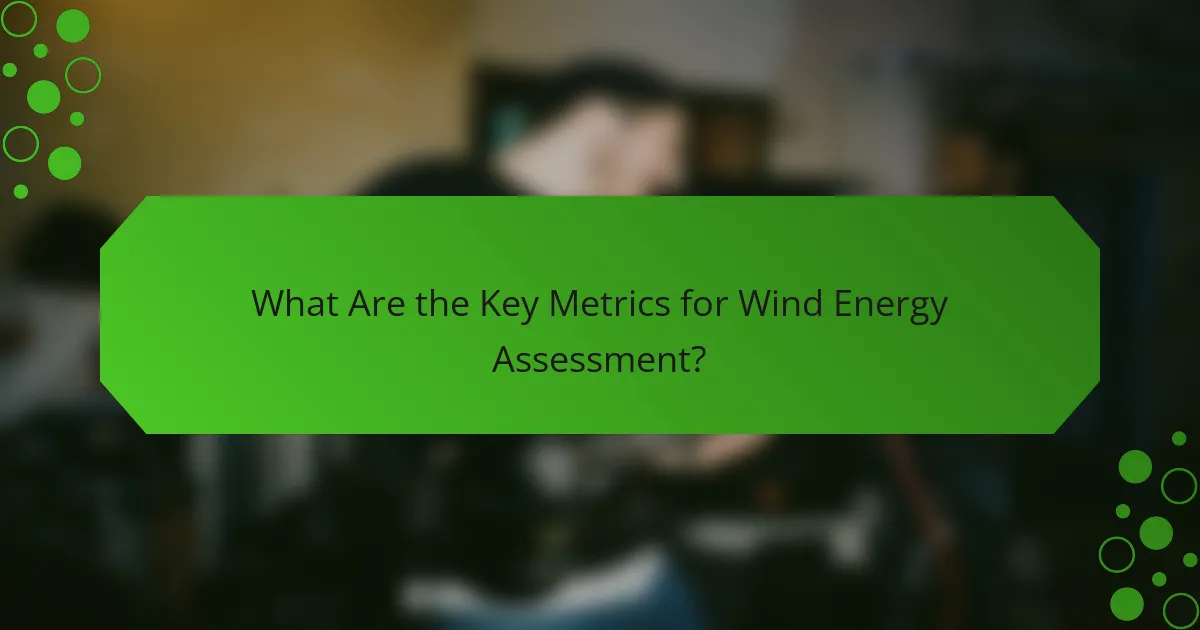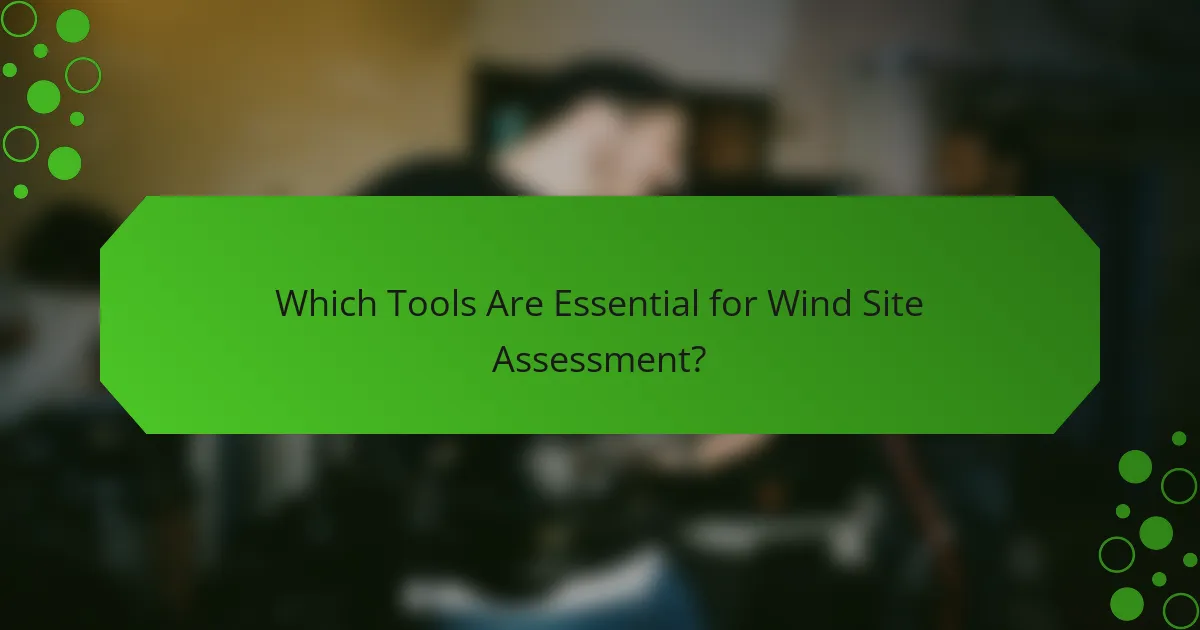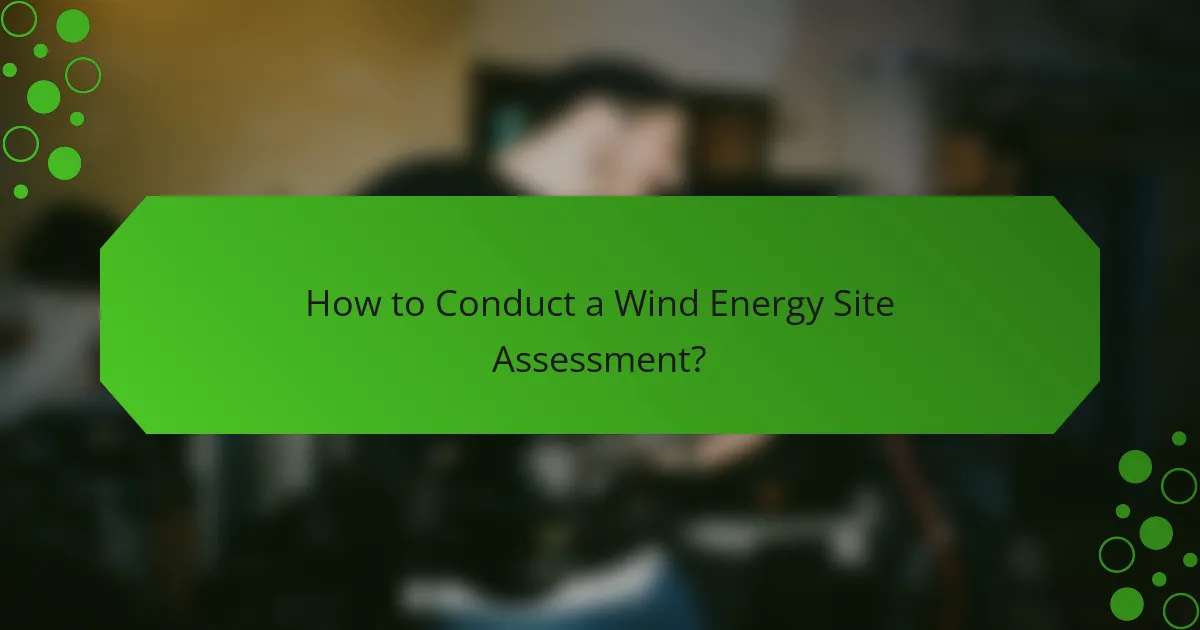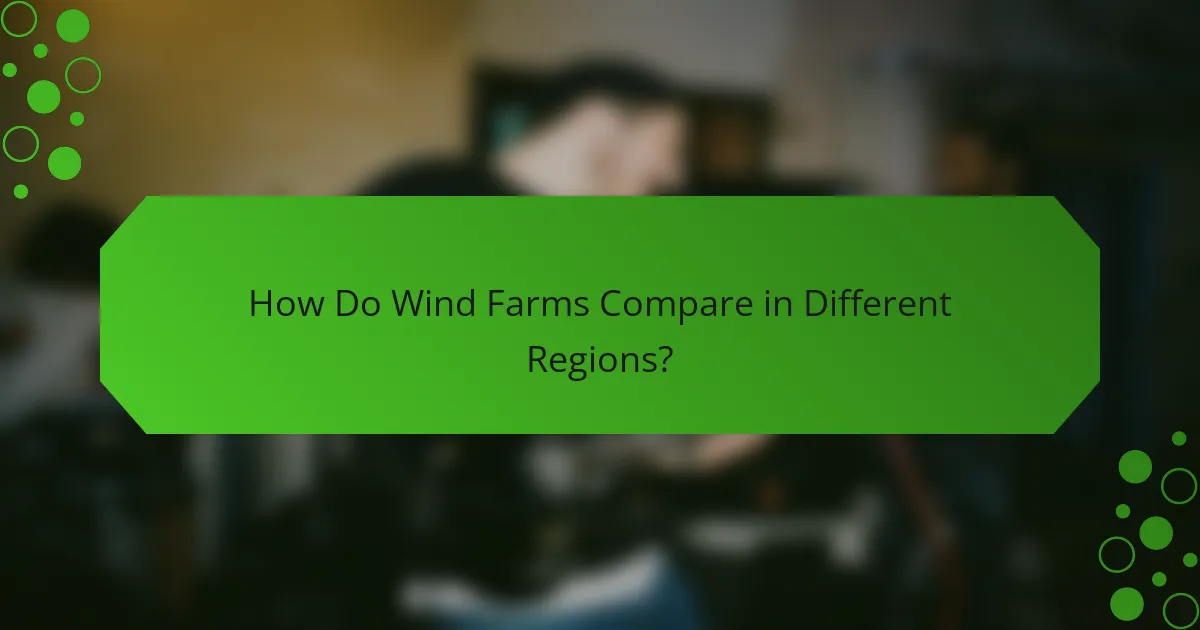Wind energy potential is assessed through a comprehensive evaluation of potential sites, focusing on critical metrics such as capacity factor, wind speed distribution, and energy production estimates. Utilizing specialized tools and technologies, this assessment process ensures optimal site selection and project feasibility, ultimately guiding investment decisions in renewable energy. By analyzing wind patterns and collecting relevant data, stakeholders can effectively determine the viability of wind turbine installations.

What Are the Key Metrics for Wind Energy Assessment?
The key metrics for wind energy assessment include capacity factor, wind speed distribution, energy production estimates, site suitability index, and return on investment. These metrics help determine the feasibility and efficiency of a wind energy project, guiding decisions on site selection and investment.
Capacity factor
Capacity factor measures the actual output of a wind turbine compared to its potential output if it operated at full capacity all the time. It is typically expressed as a percentage and varies based on location, turbine technology, and wind conditions. A capacity factor of 30-50% is common for well-sited wind farms.
To maximize capacity factor, choose sites with consistent and strong winds. Regular maintenance and optimal turbine placement can also enhance performance.
Wind speed distribution
Wind speed distribution refers to the variation of wind speeds at a site over time, usually represented by a Weibull distribution. Understanding this distribution is crucial for predicting energy production and selecting appropriate turbine models. Wind speeds are typically measured at various heights using anemometers.
When assessing wind speed, consider seasonal variations and local topography, which can significantly affect wind patterns. Long-term data collection is essential for accurate assessments.
Energy production estimates
Energy production estimates forecast the amount of electricity a wind farm will generate over a specific period. These estimates are based on wind speed data, turbine specifications, and capacity factor. Tools like wind resource assessment software can aid in these calculations.
It’s important to account for factors such as downtime for maintenance and grid connection limitations when making estimates. Regularly updating these estimates with real operational data can improve accuracy.
Site suitability index
The site suitability index evaluates the overall potential of a location for wind energy development. This index considers factors such as wind resource quality, environmental impact, accessibility, and proximity to infrastructure. A higher index indicates a more favorable site for development.
Conducting a thorough site assessment, including environmental studies and stakeholder consultations, is essential for achieving a high suitability index. This can help avoid potential regulatory hurdles and community opposition.
Return on investment
Return on investment (ROI) measures the profitability of a wind energy project by comparing the net profit to the initial investment. A positive ROI indicates that the project is financially viable. Factors influencing ROI include installation costs, operational expenses, and energy prices.
To improve ROI, consider financing options, government incentives, and long-term power purchase agreements. Analyzing market trends and energy demand can also help in making informed investment decisions.

Which Tools Are Essential for Wind Site Assessment?
Essential tools for wind site assessment include specialized software, advanced technologies, and physical measurement equipment. These tools help evaluate wind resources, optimize site selection, and ensure the feasibility of wind energy projects.
Wind resource assessment software
Wind resource assessment software is crucial for analyzing wind data and predicting energy production. These programs typically use historical weather data, terrain information, and turbine specifications to model potential energy output. Popular software options include WindPRO, WAsP, and OpenWind, each offering unique features for site analysis.
When selecting software, consider factors such as user-friendliness, compatibility with other tools, and the specific requirements of your project. Many programs offer trial versions, allowing users to evaluate their effectiveness before committing to a purchase.
LiDAR technology
LiDAR (Light Detection and Ranging) technology is a cutting-edge tool for wind site assessment that provides highly accurate wind measurements. By using laser pulses to determine distances, LiDAR can create detailed three-dimensional maps of wind profiles at various heights, which is essential for understanding wind behavior in complex terrains.
LiDAR systems can be deployed on towers or drones, offering flexibility in data collection. However, they can be expensive, so it’s important to weigh the benefits of high-resolution data against the costs, especially for smaller projects.
Wind measurement towers
Wind measurement towers are traditional yet effective tools for assessing wind resources at a specific site. These towers are equipped with anemometers and wind vanes to measure wind speed and direction at different heights. Typically, they are installed for a minimum of six months to gather reliable data.
When using wind measurement towers, ensure they are placed in representative locations, away from obstructions that could distort wind flow. Regular maintenance and calibration of the instruments are also critical to ensure accurate readings.
GIS mapping tools
Geographic Information System (GIS) mapping tools are essential for visualizing and analyzing spatial data relevant to wind site assessment. These tools allow users to overlay various datasets, such as topography, land use, and existing infrastructure, to identify optimal locations for wind farms.
When utilizing GIS tools, consider integrating data on environmental constraints, such as protected areas or residential zones, to comply with regulations and minimize community impact. Popular GIS software includes ArcGIS and QGIS, which offer various functionalities for detailed analysis and planning.

How to Conduct a Wind Energy Site Assessment?
A wind energy site assessment involves evaluating potential locations for wind turbine installation to determine their viability. This process includes analyzing wind patterns, collecting relevant data, and assessing the feasibility of the project based on various metrics.
Step 1: Preliminary site evaluation
The preliminary site evaluation is the first step in assessing wind energy potential. It involves identifying locations with favorable wind conditions, accessibility, and minimal environmental impact. Factors such as proximity to power lines and local regulations should also be considered.
During this stage, use tools like wind maps and geographic information systems (GIS) to visualize potential sites. Look for areas with average wind speeds of at least 5-6 m/s, as these are generally considered suitable for wind energy generation.
Step 2: Data collection methods
Data collection methods are crucial for obtaining accurate wind measurements. Common techniques include using anemometers, which measure wind speed and direction, and meteorological towers that gather data over extended periods. These instruments should be placed at various heights to capture the wind profile accurately.
Consider deploying remote sensing technologies like LIDAR or SODAR for more comprehensive data. These methods can provide detailed information about wind patterns without the need for extensive physical infrastructure.
Step 3: Analysis of wind data
Analyzing wind data involves interpreting the collected information to assess the site’s wind energy potential. Key metrics include average wind speed, wind direction variability, and turbulence intensity. These factors help determine the expected energy output and efficiency of wind turbines.
Utilize software tools for data analysis, which can model energy production based on historical wind data. This analysis should also consider seasonal variations, as wind patterns can fluctuate significantly throughout the year.
Step 4: Feasibility study
The feasibility study evaluates the economic and technical viability of the wind energy project. This includes estimating costs, potential revenue from energy sales, and return on investment. Factors such as installation costs, maintenance, and local incentives should be included in the analysis.
Conduct a risk assessment to identify potential challenges, such as regulatory hurdles or environmental concerns. Engaging with local stakeholders and regulatory bodies early in the process can help mitigate risks and streamline project development.

What Are the Regulatory Considerations for Wind Energy Projects?
Regulatory considerations for wind energy projects include obtaining necessary permits, conducting environmental assessments, and adhering to local and national regulations. Understanding these requirements is crucial for successful project development and compliance.
Permitting requirements
Permitting requirements for wind energy projects vary by location but generally involve multiple levels of approval from local, state, and federal authorities. Key permits often include land use permits, construction permits, and operational permits, which ensure that the project complies with zoning laws and safety standards.
It is advisable to engage with local planning departments early in the process to understand specific requirements and timelines. In many regions, the permitting process can take several months to over a year, so early preparation is essential to avoid delays.
Environmental impact assessments
Environmental impact assessments (EIAs) are critical for evaluating the potential effects of wind energy projects on local ecosystems and communities. These assessments typically analyze factors such as wildlife habitats, noise levels, and visual impacts, ensuring that the project minimizes adverse effects.
Conducting a thorough EIA not only helps in obtaining permits but also fosters community support. Engaging stakeholders and addressing concerns during the assessment process can lead to better project outcomes and smoother regulatory approval.

How Do Wind Farms Compare in Different Regions?
Wind farms vary significantly in performance and efficiency based on their geographical location. Factors such as wind speed, land availability, and regulatory environments play crucial roles in determining the viability and output of wind energy projects in different regions.
Wind Speed and Its Impact
Wind speed is a primary factor influencing the energy output of wind farms. Regions with average wind speeds above 6 meters per second (m/s) are generally considered suitable for wind energy generation. For instance, coastal areas often experience higher wind speeds compared to inland regions, making them more favorable for wind farm installations.
Higher wind speeds lead to increased energy production, but they also require turbines designed to withstand stronger forces. Therefore, selecting the right turbine for the wind conditions of a specific region is essential for maximizing efficiency and longevity.
Land Availability and Use
Land availability is another critical consideration when assessing wind farm potential. Regions with vast open spaces, such as plains or rural areas, are ideal for large-scale wind farms. In contrast, urban areas may face challenges due to space constraints and zoning regulations.
Land use also affects the installation process. For example, agricultural land can often be used for wind farms without significant disruption to farming activities. However, developers must consider local land use policies and community acceptance to ensure successful project implementation.
Regulatory Environment
The regulatory environment can greatly influence the feasibility of wind farms in different regions. Some countries or states offer incentives such as tax credits or grants to promote renewable energy projects, while others may impose strict regulations that can hinder development.
Understanding local regulations is crucial for developers. For example, in the European Union, the Renewable Energy Directive encourages member states to increase their renewable energy share, which can facilitate wind farm projects. Conversely, regions with less supportive policies may present hurdles that can delay or increase the cost of development.
